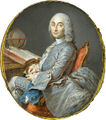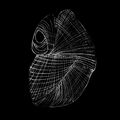Template:Selected anniversaries/June 17: Difference between revisions
No edit summary |
No edit summary |
||
| Line 1: | Line 1: | ||
<gallery> | <gallery> | ||
||1704: John Kay born ... engineer, invented the Flying shuttle | ||1704: John Kay born ... engineer, invented the Flying shuttle. No DOD. Pic. | ||
File:César François Cassini de Thury.jpg|link=César-François Cassini de Thury (nonfiction)|1714: Astronomer and cartographer [[César-François Cassini de Thury (nonfiction)|César-François Cassini de Thury]] born. In 1744, he will begin the construction of a great topographical map of France, one of the landmarks in the history of cartography. Completed by his son Jean-Dominique, Cassini IV and published by the Académie des Sciences from 1744 to 1793, its 180 plates will be known as the Cassini map. | File:César François Cassini de Thury.jpg|link=César-François Cassini de Thury (nonfiction)|1714: Astronomer and cartographer [[César-François Cassini de Thury (nonfiction)|César-François Cassini de Thury]] born. In 1744, he will begin the construction of a great topographical map of France, one of the landmarks in the history of cartography. Completed by his son Jean-Dominique, Cassini IV and published by the Académie des Sciences from 1744 to 1793, its 180 plates will be known as the Cassini map. | ||
| Line 8: | Line 8: | ||
||1821: John Henry "Professor" Pepper born ... scientist and inventor who toured the English-speaking world with his scientific demonstrations. He entertained the public, royalty, and fellow scientists with a wide range of technological innovations. He is primarily remembered for developing the projection technique known as Pepper's ghost, building a large-scale version of the concept by Henry Dircks. Pic. | ||1821: John Henry "Professor" Pepper born ... scientist and inventor who toured the English-speaking world with his scientific demonstrations. He entertained the public, royalty, and fellow scientists with a wide range of technological innovations. He is primarily remembered for developing the projection technique known as Pepper's ghost, building a large-scale version of the concept by Henry Dircks. Pic. | ||
||1832: William Crookes born . | File:Sir_William_Crookes_1906.jpg|link=William Crookes (nonfiction)|1832: Chemist and physicist [[William Crookes (nonfiction)|William Crookes]] born. Crookes will be a pioneer of vacuum tube technology, developing the partially evacuated Crookes tube circa 1869-1875. | ||
File:Charles Grafton Page.jpg|link=Charles Grafton Page (nonfiction)|1859: Inventor and crime-fighter [[Charles Grafton Page (nonfiction)|Charles Grafton Page]] uses [[Gnomon algorithm]] to forecast and prevent [[crimes against mathematical constants]]. | File:Charles Grafton Page.jpg|link=Charles Grafton Page (nonfiction)|1859: Inventor and crime-fighter [[Charles Grafton Page (nonfiction)|Charles Grafton Page]] uses [[Gnomon algorithm]] to forecast and prevent [[crimes against mathematical constants]]. | ||
| Line 32: | Line 32: | ||
||1911: Hans Maass born ... mathematician who introduced Maass wave forms (Maass 1949) and Koecher–Maass series (Maass 1950) and Maass–Selberg relations and who proved most of the Saito–Kurokawa conjecture. Pic. | ||1911: Hans Maass born ... mathematician who introduced Maass wave forms (Maass 1949) and Koecher–Maass series (Maass 1950) and Maass–Selberg relations and who proved most of the Saito–Kurokawa conjecture. Pic. | ||
||1920: François Jacob born ... biologist and geneticist, Nobel Prize laureate. | ||1920: François Jacob born ... biologist and geneticist, Nobel Prize laureate. Jacob, together with Jacques Monod, originated the idea that control of enzyme levels in all cells occurs through regulation of transcription. He shared the 1965 Nobel Prize in Medicine with Jacques Monod and André Lwoff. Pic. | ||
File:Alexander Shulgin 2009.jpg|link=Alexander Shulgin (nonfiction)|1925: Pharmacologist and chemist [[Alexander Shulgin (nonfiction)|Alexander Shulgin]] born. He will discover, synthesize, and personally bioassay over 230 psychoactive compounds for their psychedelic and entactogenic potential. | File:Alexander Shulgin 2009.jpg|link=Alexander Shulgin (nonfiction)|1925: Pharmacologist and chemist [[Alexander Shulgin (nonfiction)|Alexander Shulgin]] born. He will discover, synthesize, and personally bioassay over 230 psychoactive compounds for their psychedelic and entactogenic potential. | ||
Revision as of 07:07, 3 April 2019
1714: Astronomer and cartographer César-François Cassini de Thury born. In 1744, he will begin the construction of a great topographical map of France, one of the landmarks in the history of cartography. Completed by his son Jean-Dominique, Cassini IV and published by the Académie des Sciences from 1744 to 1793, its 180 plates will be known as the Cassini map.
1832: Chemist and physicist William Crookes born. Crookes will be a pioneer of vacuum tube technology, developing the partially evacuated Crookes tube circa 1869-1875.
1859: Inventor and crime-fighter Charles Grafton Page uses Gnomon algorithm to forecast and prevent crimes against mathematical constants.
1925: Pharmacologist and chemist Alexander Shulgin born. He will discover, synthesize, and personally bioassay over 230 psychoactive compounds for their psychedelic and entactogenic potential.
1932: Bonus Army: Around a thousand World War I veterans amass at the United States Capitol as the U.S. Senate considers a bill that would give them certain benefits.
1939: Electrical engineer Nikola Tesla uses ultra-low-frequency electrical current to detect and prevent crimes against mathematical constants. His work will later be useful in detecting and removing the Watergate scandal virus.
1972: Watergate scandal (nonfiction): Five White House operatives are arrested for burgling the offices of the Democratic National Committee, in an attempt by some members of the Republican party to illegally wiretap the opposition.
2018: Steganograpic analysis of Pilgrim unexpectedly reveals "at least two hundred kilobytes" of previously unknown Gnomon algorithm functions.







